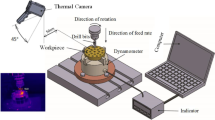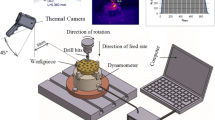Abstract
Although there have been many studies on the drillability of various grades of stainless steel, there is no scientific research on the drilling of ferritic stainless steel. Also, the burr at hole exit means the need for secondary machining operation and indirectly increases the production cost. Thus, this study focused on the modeling and minimizing burr height (Bh), thrust force (Fz) and surface roughness (Ra) during drilling of AISI 430 ferritic stainless steel with uncoated carbide drill under dry condition. Bh, Fz and Ra based on different cutting speed and feed rates were measured during drilling tests, and then cutting parameters were optimized by applying Taguchi based grey relational analysis. Moreover, the mathematical models were created by employing the response surface method to predict the machining outputs. The thrust force and the surface roughness decreased while the burr height increased with the increase in cutting speed. Uniform burr formation with drill cap was observed for all machining parameters under dry environment. The effect levels of feed rate and cutting speed on burr height were determined as 54.82% and 44.67%, respectively. These result shows that cutting speed is as important as the feed rate during the drilling of the ferritic stainless steel. In the current study, the best suitable levels of feed rate and cutting speed were detected as 0.12 mm/rev and 45 m/min for minimizing Bh, Fz and Ra. The coefficients of determination obtained by RSM indicated a relationship in high level between the cutting parameters and machining outputs.







Similar content being viewed by others
References
Kalpakjian S and Schmid S 2014 Manufacturing Engineering and Technology (7th ed.). Pearson Education, Inc, Singapore, pp. 625–665
Das R and Barik T 2014 An experimental study on the burr formation in drilling of aluminum channels of rectangular section. In: 5th International & 26th All India Manufacturing Technology, Design and Research Conference (AIMTDR), pp. 831–85
Yaǧmur S, Acir A, Şeker U and Günay M 2013 An experimental investigation of effect of cutting parameters on cutting zone temperature in drilling. J. Fac. Eng. Archit. Gazi Univ. 28(1): 1–6
Abdelhafeez AM, Soo SL, Aspinwall DK, Dowson A and Arnold D 2015 Burr formation and hole quality when drilling titanium and aluminium alloys. Procedia CIRP 37: 230–235
Patne HS, Kumar A, Karagadde S and Joshi SS 2017 Modeling of temperature distribution in drilling of titanium. Int. J. Mech. Sci. 133: 598–610
Korkmaz ME, Meral T and Günay M 2018 Drillability Analysis of AISI 420 Martensitic Stainless Steel by Finite Element Method. Gazi Journal of Engineering Sciences 4(3): 223–229
Reddy Sreenivasulu CSR 2019 Review On Investigations Carried Out On Burr Formation In Drilling During 1975 to 2020. Technol. Eng. XVI7: 43–57
Aurich JC, Dornfeld D, Arrazola PJ, Franke V, Leitz L and Min S 2009 Burrs-Analysis, control and removal. CIRP Annals-Manuf. Technol. 58(2): 519–542
Meral T and Günay M 2020 Modelling and optimization of burr height in fiber laser drilling of ferritic stainless steel. Manufacturing Technologies and Applications 1(2): 32–39
Guo YB and Dornfeld DA 2000 Finite element modeling of burr formation process in drilling 304 stainless steel. J. Manuf. Sci. Eng. Trans. ASME 122: 612–619
Kivak T, Samtaş G and Çiçek A 2012 Taguchi method based optimisation of drilling parameters in drilling of AISI 316 steel with PVD monolayer and multilayer coated HSS drills. Measurement 45(6): 1547–1557
Meral G, Sarıkaya M, Mia M, Dilipak H, Şeker U and Gupta MK 2019 Multi-objective optimization of surface roughness, thrust force, and torque produced by novel drill geometries using Taguchi-based GRA. Int. J. Adv. Manuf. Technol. 101: 1595–610
Balaji M, Venkata Rao K, Mohan Rao N and Murthy BSN 2018 Optimization of drilling parameters for drilling of TI-6Al-4V based on surface roughness, flank wear and drill vibration. Measurement 114: 332–339
Mukherjee I and Ray PK 2006 A review of optimization techniques in metal cutting processes. Comput. Ind. Eng. 50(1-2): 15–34
Gaitonde VN, Karnik SR, Achyutha BT and Siddeswarappa B 2005 GA applications to RSM based models for burr size reduction in drilling. J. Sci. Ind. Res. (India) 64: 347–353
Kumar S, Rizvi Y and Kumar R 2018 A review of modelling and optimization techniques in turning processes. Int. J. Mech. Eng. Technol. 9: 1146–56
Mondal N, Mandal S and Mandal MC 2020 FPA based optimization of drilling burr using regression analysis and ANN model. Measurement 152: 1–10
Kilickap E and Huseyinoglu M 2010 Selection of optimum drilling parameters on burr height using response surface methodology and genetic algorithm in drilling of AISI 304 stainless steel. Mater. Manuf. Process. 25: 1068–1076
Bagchi A and Guha S 2018 Parametric optimization of burr height reduction and machining time in drilling operation on stainless steel specimen. IOP Conf. Series: Mater. Sci. Eng. 377: 1–7
Balaji M, Murthy BSN and Rao NM 2016 Optimization of Cutting Parameters in Drilling of AISI 304 Stainless Steel Using Taguchi and ANOVA. Procedia Technology 25: 1106–1113
Çaydaş U, Hasçalk A, Buytoz Ö and Meyveci A 2011 Performance evaluation of different twist drills in dry drilling of AISI 304 austenitic stainless steel. Mater. Manuf. Process. 26: 951–960
Tosun N 2006 Determination of optimum parameters for multi-performance characteristics in drilling by using grey relational analysis. Int. J. Adv. Manuf. Technol. 28: 450–455.
Gaitonde VN and Karnik SR 2012 Selection of optimal process parameters for minimizing burr size in drilling using taguchi’s quality loss function approach. J. Brazilian Soc. Mech. Sci. Eng. 34: 238–245
Mavi A 2018 Gri ilişkisel analiz yöntemi ile dubleks paslanmaz çeliklerin delinmesinde yüzey form özelliklerini etkileyen optimum kesme parametrelerinin belirlenmesi. Gazi Üniversitesi Fen Bilimleri Dergisi Part C: Tasarım ve Teknoloji 6: 634–643
Lin TR 2002 Cutting behavior of a TiN-coated carbide drill with curved cutting edges during the high-speed machining of stainless steel. J. Mater. Process. Technol. 127: 8–16
Kim J, Min S and Dornfeld DA 2001 Optimization and control of drilling burr formation of AISI 304L and AISI 4118 based on drilling burr control charts. Int. J. Mach. Tools Manuf. 41(7): 923–936
Fujita N, Ohmura K and Yamamoto A 2003 Changes of microstructures and high temperature properties during high temperature service of Niobium added ferritic stainless steels. Mater. Sci. Eng. A 351(1-2): 272–281
Kaçar R and Gündüz S 2009 Increasing the strength of AISI 430 ferritic stainless steel by static strain ageing. Kov. Mater. 47: 185–91
Ahmed Y, Youssef H, El-Hofy H and Ahmed M 2018 Prediction and optimization of drilling parameters in drilling of AISI 304 and AISI 2205 steels with PVD monolayer and multilayer coated drills. J. Manuf. Mater. Process. 2: 1–16
Yaşar N 2019 Thrust force modelling and surface roughness optimization in drilling of AA-7075: FEM and GRA. J. Mech. Sci. Technol. 33: 4771–4781
Kalyon A, Günay M and Özyürek D 2018 Application of grey relational analysis based on Taguchi method for optimizing machining parameters in hard turning of high chrome cast iron. Adv. Manuf. 6: 419–429
Tekaüt İ, Demir H 2015 AISI H13 VE AISI D2 çeliklerinin delinmesi esnasında kesme bölgesinde oluşan sıcaklığa kesici takım kaplamasının ve işleme parametrelerinin etkisi. J. Fac. Eng. Archit. Gazi Univ. 30(2):289–296
Hashimura M, Chang YP and Dornfeld D 1999 Analysis of burr formation mechanism in orthogonal cutting. J. Manuf. Sci. Eng. Trans. ASME 121: 1–7
Rana A, Dongre G and Joshi SS 2019 Analytical modeling of exit burr in drilling of Ti6Al4V alloy. Sadhana 44: 1–19
Audy J 2008 A study of computer-assisted analysis of effects of drill geometry and surface coating on forces and power in drilling. J. Mate.r Process. Technol. 204(1–3): 130-138
Küçüktürk G 2013 Modeling and analyzing the effects of experimentally determined torque and thrust force on cutting tool according to drilling parameters. Proc. Inst. Mech. Eng. Part B J. Eng. Manuf. 227: 84–95
Korkmaz ME and Günay M 2018 Finite element modelling of cutting forces and power consumption in turning of AISI 420 martensitic stainless steel. Arab. J. Sci. Eng. 43: 4863–4870
Amran MA, Salmah S, Hussein NIS, Izamshah R, Hadzley M, Sivaraos, Kasım MS, Sulaiman MA 2013 Effects of machine parameters on surface roughness using response surface method in drilling process. Procedia Eng. 68: 24–29
Acknowledgements
This study was partly supported by Karabük University (KBÜ-BAP-17-YL-248) and the authors express their gratitude to the support of Scientific Research Project Unit.
Author information
Authors and Affiliations
Corresponding author
Rights and permissions
About this article
Cite this article
Günay, M., Meral, T. Modelling and multiresponse optimization for minimizing burr height, thrust force and surface roughness in drilling of ferritic stainless steel. Sādhanā 45, 273 (2020). https://doi.org/10.1007/s12046-020-01490-3
Received:
Revised:
Accepted:
Published:
DOI: https://doi.org/10.1007/s12046-020-01490-3




